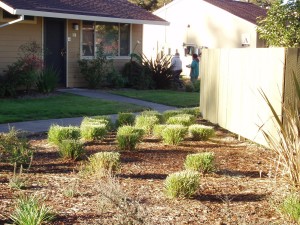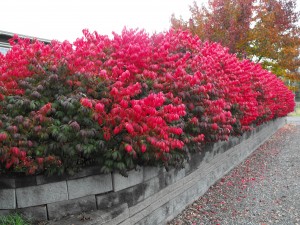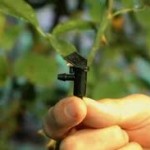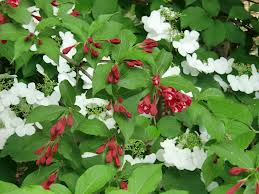Posts Tagged summer
Go Native, Save Water: Xeriscape Gardening
 The information age has brought with it a flood a varying techniques in the fields of landscaping, gardening and ecological design. In keeping with the sustainable nature of the best of them, xeriscape gardening is defined by its optimal use of a minimal amount of water. This approach to gardening has been developed in the arid regions in the world, chiefly in the American mid-west, as a natural response to the climate. Xeriscape is most effective when the need for supplemental irrigation is eliminated and the design of the garden promotes symbiotic relationships that provide benefits. Environmental conservancy is xeriscape gardening’s top priority, but aesthetic design has received as much consideration. At its best, xeriscape becomes a melding of both utility and beauty.
The information age has brought with it a flood a varying techniques in the fields of landscaping, gardening and ecological design. In keeping with the sustainable nature of the best of them, xeriscape gardening is defined by its optimal use of a minimal amount of water. This approach to gardening has been developed in the arid regions in the world, chiefly in the American mid-west, as a natural response to the climate. Xeriscape is most effective when the need for supplemental irrigation is eliminated and the design of the garden promotes symbiotic relationships that provide benefits. Environmental conservancy is xeriscape gardening’s top priority, but aesthetic design has received as much consideration. At its best, xeriscape becomes a melding of both utility and beauty.
The Principles of Xeriscape
As conceived by Denver Water, xeriscape gardening’s most revered proponent, these seven guiding principles provide the foundation for all considerations within the field. Each principle holds an entire discipline within itself, which means that there is always more to learn and improve upon in this field.
- Planning and Design are the cornerstones of effective gardening, which requires careful attention to your specific environment.
- Soil Management is about knowing what nutrients your selected plants need and what nutrients are available in the soil. Composting is a great way to reinvigorate malnourished soil.
- Plant Selection is an integral part of xeriscape gardening. Thousands of species exist in arid conditions, each with benefits and beauty to offer.
- Turf Minimalism is crucial because the water needs of most grass lawns makes them impractical for dry climates.
- Diligent Irrigation may be the reason you’re interested in xeriscape gardening to begin with. Water is an invaluable resource and appropriate use of it is essential to environmental conservancy.
- Mulch can be composed of several materials such as leaves, wood chips, pine needles and bark. It is spread over the surface of the soil to help with water retention, fertility, prevention of erosion, and reduction of weed growth.
- Maintenance in the form of weed pulling, mulching, and general upkeep should be combined with constant observation to check if your garden layout is working to its full potential.
The Benefits of Xeriscape
- Reduced Water Consumption is both the key aspect of xeriscape gardening and a great benefit of it. It means using less water and making better use of it. Not only will this save you money, but you will be helping your community and environment as well. Re-appropriating rainwater can help you prevent evaporation and runoff, and your garden’s layout can be optimized for better use of it.
- Less Maintenance is required from a xeriscape garden. Much less fertilizer is used, which helps urban runoff pollution, lawn mowing becomes nigh unnecessary, and simple irrigation systems can handle all of your watering needs.
- Pest Control is an added benefit of a really well thought out garden layout. Certain xeriscape friendly plants ward off insects, while prickly cacti do the same for intrusive mammals. Plant selection also enables you to create a sanctuary for desirable birds and insects.
- Property Values Rise when you drought-proof the terrain around your home. Likewise, the design opportunities available to xeriscape can make for some exquisite gardens.
There are an abundance of tips and tricks available for do-it-yourself xeriscape gardening, but expert consideration reaps the true benefits of the art form. Xeriscape specialists develop an uncanny ability to read an environment and discern its possibilities. With a little help, and dedication to the sustainability principles of xeriscape you could be looking at a lower water and power bill, a productive and efficient garden, and a beautiful area in which to relax.
Front Yard Flower Bed Ideas – DK Landscaping
 Want to make your home look calm, inviting, and happy? Add flower beds to your property for constant color. Use the beds to delineate property or break up bland expanses of lawn grass and dirt. Finding flower bed ideas is simple, but you should be sure of what you need and why. There are so many possible flower bed ideas that you can get easily bogged down in details if you start to look for designs without taking issues like drought and level of care into consideration. Pinpoint non-negotiable issues like those first to make designing your front yard a lot more efficient.
Want to make your home look calm, inviting, and happy? Add flower beds to your property for constant color. Use the beds to delineate property or break up bland expanses of lawn grass and dirt. Finding flower bed ideas is simple, but you should be sure of what you need and why. There are so many possible flower bed ideas that you can get easily bogged down in details if you start to look for designs without taking issues like drought and level of care into consideration. Pinpoint non-negotiable issues like those first to make designing your front yard a lot more efficient.
Drought-Proof Flower Bed Ideas
Drought is probably going to be one of your main considerations when looking at flower bed ideas. Many areas of the country are experiencing water shortages, and anything you plant has to be able to deal with a lack of abundant water. That doesn’t mean you have to plant cacti — just look for cultivars of flowers that have been bred to be less water-needy. Native flowers are always a wonderful choice in this case as they are already somewhat adapted to their region’s fluctuating water supplies. Plant breeders have been working on drought- and disease-resistant cultivars of all sorts of plants for years, and it’s become easier to find these in garden centers and from landscaping companies when looking at flower bed ideas.
Easy Care Flower Bed Ideas
Ease of care is another big consideration for flower bed ideas. Even if you have a landscaping company taking care of most of your garden, you’ll still have to do some minor care yourself. If you don’t feel up to that, you’ll want flower varieties that can handle benign neglect. Again, native flowers tend to be a little better for this, though there are easy-care species from all over the country if you’d like more variety for your flower bed ideas.
Location Ideas For Your Flower Bed
Now take a look at location to further refine your flower bed ideas. Flower beds that will be near the street need to be able to handle road salt spray, for example, if your area tends to have occasional snowfall in spring or fall. That’s not so much of a problem with annuals, as you’d be removing them anyway, but if can be for perennial or biennial flowers.
Flower bed ideas for spaces near fences can have species of varying heights, so those plants nearer the fence should be taller. The shorter flowers near the edge of the bed may need to be shade-tolerant if the bed is positioned where the fence or taller plants might block a lot of the sunlight.
Reduce Insects
Flowers planted next to the house need to be pest-resistant if possible. While it is impossible to guarantee that a flower will never attract a bug, if you have flowers that tend to attract pests, those pests could get into your house. Ask your garden center or landscaping company to show you flowers that have a reputation for repelling insects, too, such as marigolds, petunias, and nasturtiums. As you come up with ideas for other areas of your yard, you can work a few of these plants in so that you can reduce the number of pests you have to deal with overall. Start talking to landscape design companies about flower bed ideas and species that fit what you need for your yard’s environment, and you’ll have a beautiful yard in no time.
What’s Growing On?
Flowers always make people better, happier, and more helpful; they are sunshine, food and medicine for the soul. ~ Luther Burbank
Around this time of year I start to get spring fever, that urge to go outside and dig around and plant something. Even if you naturally don’t have a green thumb, flower gardening allows you to use your artistic playful side, being outside in nature soothes your soul, and a beautiful flower garden increases the curb appeal of your home. One of the first things a flower gardener learns is that there is not one date when it is best to plant all flowers.
This group of exotic and tropical summer bloomers can be planted right now and all through April in most of the country; planting times for colder regions of the North are typically from April to June, depending on the bulb.

Cannas are a personal favorite for their showy, tropical-like flowers and vibrantly-colored or variegated banana-like leaves. Dahlias offer numerous flower types from dazzling daisies, to showy pom poms, to show-stopping colorful blooms. Other note-worthy spring-planted bulbs include gladiolus, windflower (Anemone coronaria), pineapple lily (Eucomis), freesia, summer hyacinth (Galtonia), begonia, red hot poker (Kniphofia), Asiatic and Oriental lilies (Lilium), and Aztec lily (Sprekelia). 
So start by finding an empty spot in your yard that you see frequently that could use some color. If you don’t have an open bed, remove a patch of lawn in front of shrubs. Measure the size and note what time of day and how long the sun shines on that spot. Consider the following when designing your garden: hardiness, color, fragrance, height, time of bloom and size of plant. Do you want to attract hummingbirds, butterflies, or song birds? Or are you trying to create a work of beauty just for you? Next, visit your favorite full service nursery. They will help you pick out the right flowers for that spot. And be sure to ask about fertilizer, weed preventer and mulch.
Here are three easy ways to start planting your summer bulbs:
- Start with bulbs that are plump, firm and feel heavy for their size. Prep the soil by working a complete fertilizer into the entire bed or bottom of planting holes.
- Arrange the bulbs in groups or random clusters, then plant them at the depth recommended on the package with the pointed side or sprouting side facing up.
- Cover the bulbs with soil mixed with compost and keep the soil moist to slightly moist from planting until the foliage of the mature plant dies back.
One of the biggest things about gardening is the upkeep, depending on the plants and flowers you choose this can require little maintenance or high maintenance. Be realistic about your daily scheduled and how much effort you are willing to put in weekly to maintain your gardens.
Work all day? Busy with kids? Then opt for low maintenance plants that need very little maintenance or call DK Landscaping to keep your yard looking beautiful all year long! (707) 280-3632.
The Art of Irrigation

One of the challenges for a gardener is managing the proper use of water. The lack of water can be damaging, or deadly, to anything growing outside. DK Landscaping shares the art of irrigation and will help you prepare your garden for it.
Benefits of Drip Irrigation
By using drip irrigation, your garden will use less water, will require less maintenance, and help discourage less weeds and pests. You will be giving them the moisture they need, where they need it: at their root zone.
It will save you up to 90% compared to watering with a hose. It saves you time having your drip system on a timer. You control your irrigation timer and adjust it for seasonal changes (for instance, August heat in Northern California consumes the most water). Together with mulch creates an organic weed control without the use of harsh and unhealthy chemicals. Watering only the roots of your plants with drip irrigation also cuts down on water-borne pests and fungal diseases that spread by water movement.

With a timer, you can control how much water your plants receive by setting up your drip system with different size emitters, which are the system’s delivery mechanism. You can use a small emitter, such as one that delivers 1/2 gallon of water per hour, at the base of small plants, such as herbs; for larger plants, such as trees, you can provide more than one emitter that delivers 3 gallons of water per hour, or more.
DK Landscaping also recommends that all valves feeding the drip system should have:
Large Filter: A small filter or no filter will result in debris clogging the system.
Pressure Reducer: Absence of it will result in emitters being blown off the main feed line. Drip systems are designed to work under low pressure (nominally between 25 PSI to 35 PSI) while normal pressure on the water main line is nominally 70 PSI.
Pressure Compensated Emitters: Pressure compensating drip emitters (PC Emitters) deliver a consistent output of water, even with increase changes in elevation or pressure due to long drip runs. PC Emitters are best used in landscapes and gardens that have drops in elevation that would cause an increase in pressure.
Emitter Hole Punch: Oval or wrongs size holes will result in leaks.
For more information and a free consultation on your irrigation system, please contact Kathy Lee at DK Landscaping. Kathy is our QWEL (Qualified Water Efficient Landscaper) Certified Irrigation Expert. We are also a certified WaterSense Partner. QWEL and WaterSense are certified by the EPA.
Irrigation Sensation
Summer is just around the corner which means, for most of us…the “dog days” are coming!
DK Landscaping brings you tips on how to beautify your landscape while maintaining the lusciousness of your lawn through irrigation.
A great lawn is a start to an exceptional landscape. Landscaping will not only make your property look better, but will also raise your property values. Adding effects and color can increase the value of your home and property by as much as 10% depending on your lawn, landscape and property.
Watering your lawn is essential to protect your landscaping investment. A residential sprinkler system improves the overall health of all plantings because of the consistent water being delivered. It not only helps manage your water usage — but you will have a greater appreciation for when your water bill arrives each month.
DK Landscaping recommends the best time to water your lawn is in the morning, before the heat of the day has set in, so moisture has time to evaporate before the evening. Watering in the evening can result in rot and fungal infections of the plant roots being left moist and cold at night. We also believe it is far better to water a lawn deeply once a week than to give it shorter periods of water more frequently.
For more information and a consultation on your irrigation system, please contact David Lee at DK Landscaping.








